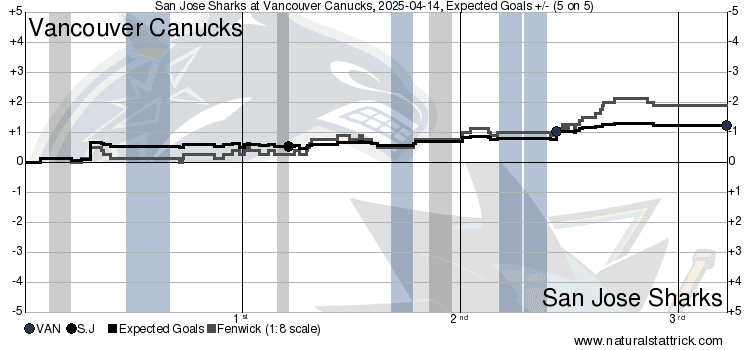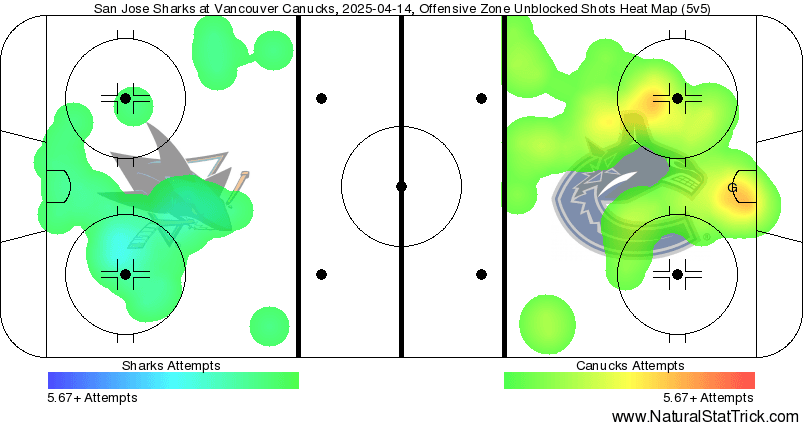Do you prefer the Canucks season that was the long painful divorce with Pavel Bure or the long painful divorce with Roberto Luongo or the long painful divorce with Bo Horvat or the long painful divorce with J.T. Miller or the long painful divorce with Brock Boeser or the long pa-
Nation Sites
The Nation Network
CanucksArmy has no direct affiliation to the Vancouver Canucks, Canucks Sports & Entertainment, NHL, or NHLPA
The Statsies: Linus Karlsson’s big night spurs Canucks over Sharks

Photo credit: Bob Frid-Imagn Images
By Michael Liu
Apr 15, 2025, 14:02 EDT
It’s all starting to wrap up now.
The Vancouver Canucks defeated the San Jose Sharks by a 2-1 overtime scoreline. According to the stats, though, it really shouldn’t have been close. Vancouver handily dominated San Jose through every period and every metric, with a lack of finishing being the biggest reason why they were held to just one goal in regulation. Still, the better team won, and the numbers will show that in spades
Here’s the win, by the numbers.
As always, you can find our glossary guide of advanced stats here.
Game Flow

While the trend line looks pretty flat, direct attention to the Y-axis, and the scale becomes rapidly apparent. The Canucks throroughly dominated the Sharks through this entire game, not allowing them a single sinff of momentum at 5v5 play. They only improved period from period, going from 52.94 CF% in the first to 57.14 CF% in the second, then finishing off with a 70.00 CF% in the third. That was coupled with them never finishing below 61.00 xGF%, totalling 2.21 xGF at 5v5 play for the entire contest. Meanwhile, the Sharks finished below one expected goal, with a 0.99 xGF to their name.
Heat Map

The heat map also doesn’t look the most impressive until considering the scale at the bottom of the graphic. Overall, the Canucks had a 27-14 edge in scoring chances, with a further 11-4 lead in high-danger chances. The disparity between the two teams can be seen in the fact that the Sharks simply didn’t have a hot spot to begin with, while the Canucks managed to register one that was on the upper-middle end of the scale. Of the 11 HDCF, nine of them came in the first two periods, with just two in the final frame. That’s probably not what the team wanted, but at least one of them led to a goal. The gap only stretched when accounting for all situations as well – Vancouver had a dominating 54-18 scoring chance lead and 24-5 high-danger chance advantage. They should’ve blown the Sharks out.
Individual Advanced Stats
Corsi Champ: Linus Karlsson led the way with a 77.78 CF% last night, playing together on a line with Teddy Blueger and Drew O’Connor, which caused plenty of headaches for San Jose. They consistently generated offensive pressure, allowing the Canucks to keep on building as the unit took full advantage of their lesser opposition. And it wasn’t like it was complete nobodies either – Karlsson did find himself matched up just the same amount with the Sharks’ second line as their third line.
Linus Karlsson should have a spot on the #Canucks’ 4th line next season. He can bury pucks around the net and can be a pest out there. Protects the puck well and is strong along the boards. Like the edge he plays with.
Corsi Chump: In what could be one of Brock Boeser’s final games as a Vancouver Canuck, the winger brought up the rear of the Corsi department with a 44.44 CF%. That also left Boeser as the worst xGF% man on the team, splitting a 50.00 with a team-low 0.27 xGF. Again, it’s not the worst kind of numbers to be putting up, and when the worst player on the team is hitting those benchmarks, it shows a good team effort. However, relative to the rest of the Vancouver roster, Boeser didn’t play the best.
Back for the sad Brock Boeser farewell tour. Two more games left.
xGF: Linus Karlsson features in this category with an overwhelming statistical advantage compared to the rest of the team. His 91.64 xGF% stood at 37.96 xGF% rel to team average, with his 1.2 xGF ranking him third in that category behind Drew O’Connor and Teddy Blueger, who tied for the team’s best xGF at 1.22. Karlsson was on ice for a 9-1 scoring chance advantage and a massive 6-0 HDCF lead as well. He’s been impactful in the lineup since being called up again, and one has to think that this has earned him a longer run with the big club starting next year.
Juicy, juicy rebound by Georgiev and Linus Karlsson ties the game! #Canucks
GSAx: Nikita Tolopilo made his NHL debut last night and didn’t look too out of place at all. Besides one insane snipe by Macklin Celebrini on the power play (off a low-danger shot attempt, at that), Tolopilo turned aside a big chunk of shots for a 0.35 GSAx. Not a bad result by any means, with the Canucks palying very well in front of him to keep San Jose from getting much momentum rolling. Tolopilo at the very minimum held up his end of the bargain for the Canucks’ win.
Nikita Tolopilo makes a nice glove save! He's been solid for the Canucks in his debut. 🎥: Sportsnet | #Canucks
Statistical Musing
Kirill the Thrill: Okay, maybe not like that or like Kaprisov, but Kirill Kudryavtsev made his NHL debut last night as well and looked more than solid. Playing alongside Victor Mancini on the Canucks’ third pairing, Kudryavtsev posted some impressive numbers as he racked up the fourth-best CF% (68.42) and 4th-best xGF% (79.60). He tied for third-best in xGA at 0.17, on ice for an 8-2 scoring chance advantage. Again, considering that it’s the Russian’s first NHL action, this is pretty great to be seeing already.
Kirill Kudryavtsev leads all defencemen in Corsi % so far tonight. #Canucks ahead of #TheFutureIsTeal 4-1 in scoring chances with the rookie on the ice at five-on-five.
As a team
CF% – 69.67% HDCF% – 82.76% xGF% – 81.89%
The scoreline definitely doesn’t reflect the overwhelming dominance the Canucks displayed last night. It was thanks to some poor finishing and Georgiev playing out of his mind that this game went to overtime, but the final result was the one that this team deserved. It’s been a frustrating season, so to see the Canucks put together some solid performances to close out the year is a welcome sight. The hope is that it will translate into the 2025-26 campaign.
Vancouver will host the Vegas Golden Knights for their final game of the season tomorrow night.
Stats provided by naturalstattrick.com
Sponsored by bet365
Breaking News
- Is there a number at which a Kiefer Sherwood extension would make sense for the Canucks?
- The Statsies: Filip Hronek leads Canucks in CF% in 5-3 loss to Sabres
- The Stanchies: Canucks nearly ruin the perfect tank game, still find a way to lose 5-3 to Sabres
- Instant Reaction: Canucks battle back to make it close, but fall 5-3 to Sabres
- ‘Do it for once, please’: Jannik Hansen wants the Canucks to sell high and trade Kiefer Sherwood

